A student (N.C.) sent me this neat video based on the If the World Were a Village website. I plan to show it to my environmental science class because we’ve been talking about human population recently.
Month: January 2013
Patterns in the Periodic Table
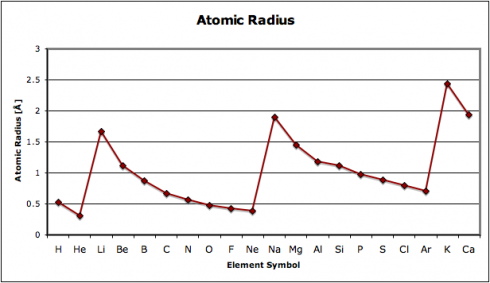
Why is the periodic table called the periodic table? Because of the periodic changes in the properties of the elements: there are patterns to the properties that repeat, time after time, as you go through the sequence of the elements. One key repetition, which affects the way different elements react, is in the electron configurations, however, other properties change as well. In fact, history of the periodic table
is a story of scientists trying to figure out the properties of unknown elements (not to mention figuring out that there were undiscovered elements) based on what they knew about the periodicity of the known elements.
File: periodic-table-properties.xls
In this exercise, we look at four different properties that students need to be aware of: density, melting point, ionization energy, and electronegativity. I’ve compiled the data in this spreadsheet: periodic-table-properties.xls; and I handed out the first page, with the properties of the first 38 elements (periodic-table-properties.xls.pdf).
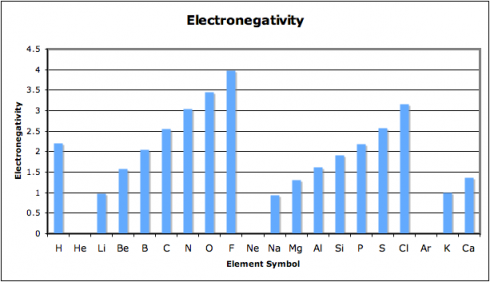
I broke the class into pairs and had each pair graph one of the four sets of data. With 16 students that meant that we had a replicate of each graph, so I could use the redundancy as a quick check that they’d done them correctly.
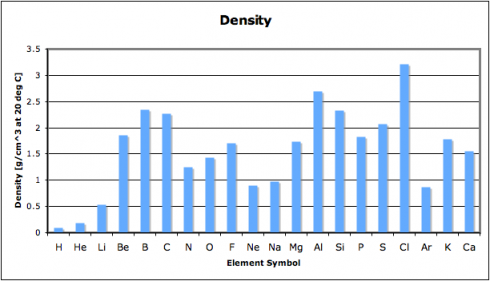
As they put drew their graphs I went around the classroom, paying special attention to the students working on ionization energy and electronegativity. Especially for the latter, I’d picked pairs who I figured would be able to get the graphs done quickly but would appreciate the extra challenge of figuring out what electronegativity actually is. This way, when everyone was done, the students could use their graphs to look for the patterns and explain what they’d found to the rest of the class.

Electron Configurations on the Periodic Table
Having demonstrated how to draw a few simple atoms, I had students fill out a periodic table template with drawings of the first twenty atoms. Actually, I only had them draw the electrons in their shells because it reduced the messiness of trying to fit in forty nuclear particles into a small tile, and the point I wanted to get at was the pattern of shells and valence electrons in the periodic table.
The end result looked something like this:
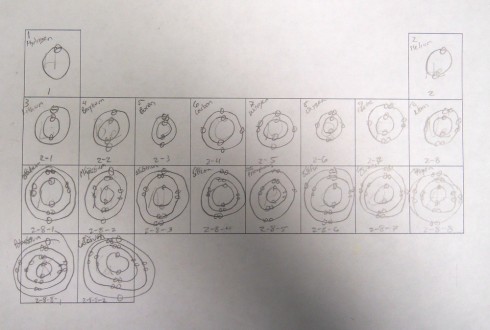
All the drawing only took about 15 minutes, and once they’d figured out the first half dozen or so it started to get a little boring. But that freed up the cognitive resources so they could notice the two key patterns.
- First, each row in the periodic table has an additional electron shell.
- Second, as you go across a row you add one electron to the shell until it is filled.
It’s a first glimpse at the periodicity in the periodic table. And it sets us up nicely to be able to talk about chemical bonding.
Terraforming Earth

Charles Darwin and colleagues attempted to vegetate the barren, volcanic Ascension Island with plants from botanical gardens around the world. Essentially, it was an experiment in transforming. And it worked. Howard Falcon-Lang has the details at the BBC.

Drawing Atoms
This year, I’ve been basing my introduction to basic chemistry for my middle school students around the periodic table of the elements. The first step, however, is to teach them how to draw basic models of atoms.
Prep: Memorization over the Winter Break
I started it off by having the students memorize the first 20 elements (H through Ca), in their correct order — by atomic number — over their winter break.
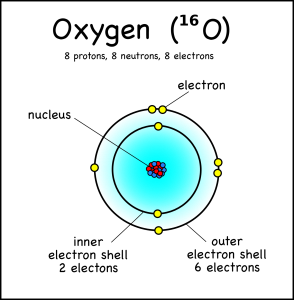
So that they’d have a bit of context, I went over the basic parts of an atom (protons, neutrons, and electrons) and made it clear that the name of the element is determined solely by the number of protons. I even had them draw a few atoms with the protons and neutrons in the center and the electrons in shells. Since I’d dumped all of this on them in a single class period, it probably was a bit much, but since it was just to give them some context I did not expect the 7th graders, who had not seen this before, to remember it all; for the 8th graders it should have been just a review.
Most students did a good job at the memorization. Some found songs on the the internet that helped, while others just pushed through. Having the two weeks of winter break to work on it probably helped too.
Day 1. Lesson: The Parts of an Atom
When we got back to school, the first thing I did was give them an outline of the upper part of the periodic table and asked them to fill it in with the element names.

After they’d filled out their periodic table template, I went into the parts of the atoms in more detail, and had them practice. The key points I wanted them to remember were:
-

The atomic number is written as a subscript to the left of the element symbol. The atomic number is the number of protons. Since they memorized the elements in order, they should be able to figure this out on their own — but they could also look it up quickly on the periodic table, or look at the element symbol where the atomic number is sometimes written on the lower left.
- The atoms have the same number of electrons as protons. Protons are positively charged, and electrons are negatively charged, so an atom needs to have the same number of both for its charge to be balanced. We don’t talk about ions –where there are more or less electrons– until later.
-

The atomic mass (4) is written as a superscript to the left of the element symbol. The atomic mass is the sum of the number of protons (2) and the number of neutrons (2). The small atoms that we’re looking at tend to have the same number of neutrons as protons, but that’s not necessarily the case. So how do you know how many neutrons? You have to ask, or look at the atomic mass number, which is usually written to the upper left of the atom. Since the atomic mass is the sum of the number of protons and neutrons, if you know the atomic mass and the number of protons, you can easily figure out the number of neutrons. (Note that electrons don’t contribute to the mass of the atom because their masses are so much smaller than the masses of neutrons and protons.
-
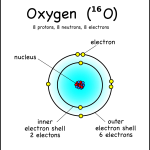
This oxygen atom has 8 electrons in two shells. Electron Shells: Electrons orbit around the nucleus in a series of shells. Each shell can hold a certain maximum number of electrons (2 for the first shell; 8 for the second shell; and 8 for the third). And to draw the atoms you fill up the inner shells first then move on to the outer shells.
So, if I wrote just the element symbol and its atomic mass on the board that students should be able to figure out the number of particles.
Example: Carbon-12
For example, the most common form (isotope) of carbon-12 is written as:
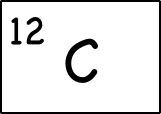
- Protons = 6: Since we know the atomic number is 6 (because we memorized it), the atom has 6 protons.
- Neutrons = 6 : Since the atomic mass is 12 (upper left of the element symbol), to find the number of neutrons we subtract the number of protons (12 – 6 = 6).
- Electrons = 6: This atom is balanced in charge so it needs six electrons with their negative charges to offset the six positive charges of the six protons. (Note: we haven’t talked about unbalanced, charged atoms yet, but the charge will show up as a superscript to the right of the symbol.)
- Electron shells (2-4): We have six electrons, so the first two go into filling up the first electron shell, and the rest can go into the second shell, which can hold up to 8 electrons. This gives an electron configuration of 2-4.

Example: Carbon-14
Carbon-14 is the radioactive isotope of carbon that is often used in carbon dating of historical artifacts. It is written as:

- Protons = 6: As long as it’s carbon it has six protons.
- Electrons = 6: This atom is also balanced in charge so it also needs six electrons.
- Neutrons = 8 : With an atomic mass of 14, when we subtract the six protons, the number of neutrons must be 8 (14 – 6 = 8).
The only difference between carbon-12 and carbon-14 is that the latter has two more neutrons. These are therefore two isotopes of carbon.
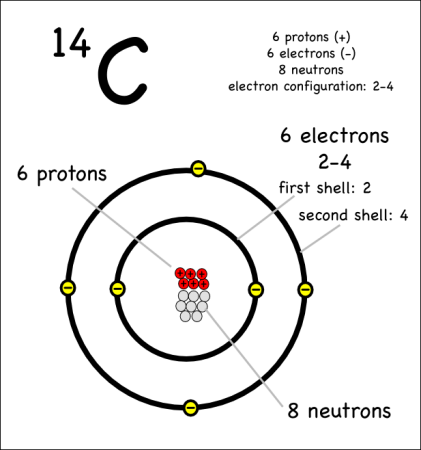
Example: Helium-4

Example: Sodium-23
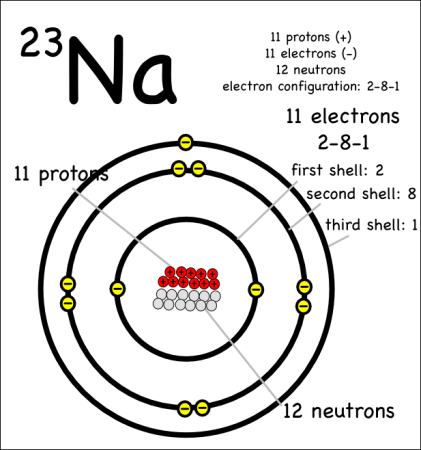
Note: A picture of a hydrogen atom can be found here.
Update: I’ve created an interactive app that will draw atoms (of the first 20 elements), to go with a worksheet for student practice.
Nuclear vs. Chemical Energy
This curious video advocates for a new type of nuclear reactor (that runs on thorium) over traditional uranium reactors and chemical fuels. In doing so it gives a useful, but quick, explanation of how energy is produced from these sources.
Building Physical Models of Geography
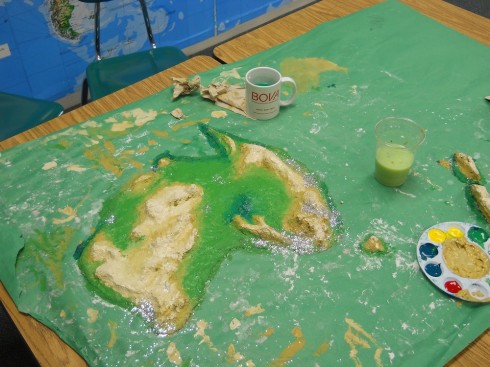
Dr. Austin has the middle school students build physical models of the continents as an exercise in geography. They use some type of cellulose clay to shape the topography then paint on or apply other icons to represent other types of spatial data; one group, for example, used sparkles to represent population.
The final models are nice for trying stop-motion fly-throughs.
A Planet Being Formed
In the early stages of the formation of a solar system, dust in the nebula around a young star is attracted to each other because of their minute gravitational attraction to each other.
In the video below, accumulation of dust and gas creates a planet, probably a gas giant, that clears a swath of the solar nebula.